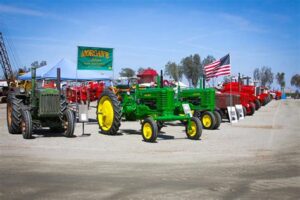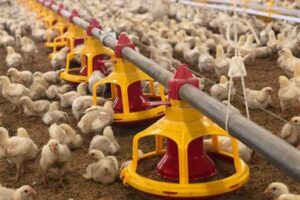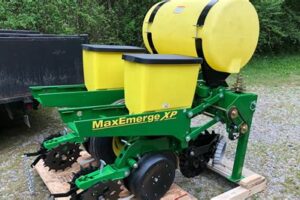Table of Contents
Discover the fascinating world of 1800s farm equipment, where innovation and ingenuity revolutionized agricultural practices. Explore the evolution of tools such as plows, seed drills, and reapers that transformed farming into a more efficient and productive endeavor. Learn about the challenges faced by farmers during this era and how these machines played a pivotal role in shaping the agricultural landscape. Uncover the rich history of 1800s farm equipment and its lasting impact on modern farming practices.
During the 1800s, the agricultural industry experienced a significant transformation with the introduction of new and innovative farm equipment. These advancements revolutionized farming practices and paved the way for increased productivity and efficiency. Transitioning from traditional manual labor to mechanized tools was a game-changer, allowing farmers to accomplish tasks that were previously time-consuming and physically demanding. The adoption of cutting-edge machinery marked a turning point in the history of agriculture, propelling the industry into a new era of prosperity and growth.
The Evolution of 1800s Farm Equipment
The 1800s were a transformative time in agriculture, marked by significant advancements in farm equipment. As the Industrial Revolution took hold, traditional farming methods gave way to more efficient and mechanized processes. This article explores some of the key farm equipment innovations that revolutionized farming during this era.
The Plow: A Staple of 1800s Farm Equipment
One of the most fundamental pieces of farm equipment in the 1800s was the plow. Prior to this period, plows were often made of wood and had limited effectiveness. However, the 1800s saw the emergence of cast iron plows, which greatly enhanced their durability and efficiency. This innovation allowed farmers to till the soil more effectively, leading to increased crop yields.
The Reaper: Revolutionizing Harvesting
In the early 1800s, harvesting crops was a labor-intensive task. However, the invention of the reaper changed the game. The reaper was a horse-drawn machine that cut and gathered crops, significantly reducing the manpower required for harvesting. This innovation not only saved time and energy but also allowed farmers to increase their productivity and expand their operations.
The Thresher: Enhancing Grain Processing
Processing grain was another time-consuming task on 1800s farms. The advent of the thresher, a machine that separated grain from the straw and chaff, greatly improved efficiency. Farmers no longer had to manually beat the crop to separate the useful grain, saving considerable effort and increasing output. This enabled them to bring their crops to market more efficiently and profitably.
The Steam Engine: Powering the Farm
One of the most significant advancements in 1800s farm equipment was the steam engine. Steam engines provided reliable and portable power for various farm operations, such as grinding grain, threshing, and sawing wood. They were also instrumental in powering locomotives, which revolutionized transportation and allowed for the faster distribution of agricultural goods.
The Seed Drill: Precision Planting
Prior to the introduction of the seed drill, planting seeds was a labor-intensive and imprecise process. The seed drill changed this by enabling farmers to plant seeds at a consistent depth and spacing. This not only saved time but also ensured more uniform crop growth and higher yields. The seed drill was a significant contributor to the agricultural productivity of the 1800s.
The Mower: Streamlining Hay Production
Hay production was vital for feeding livestock in the 1800s, and the invention of the mower revolutionized this process. Mowers allowed farmers to cut grass efficiently, significantly reducing the time and effort required. This advancement facilitated the growth of large-scale livestock operations and improved the overall health and productivity of farm animals.
The Corn Planter: Boosting Corn Production
Corn was a staple crop during the 1800s, and the corn planter greatly increased its production. This machine mechanized the process of planting corn seeds, allowing for precise spacing and depth. The corn planter enabled farmers to plant larger areas of land efficiently, leading to higher corn yields. This innovation played a significant role in meeting the growing demand for corn-based products.
The Threshing Machine: Efficient Grain Harvesting
Harvesting grain from the stalks was a laborious task before the advent of the threshing machine. This machine separated the grain from the straw and chaff, automating a process that was previously done manually. The threshing machine greatly increased efficiency, allowing farmers to harvest larger quantities of grain in less time. This innovation revolutionized grain production and paved the way for modern farming practices.
The Milking Machine: Transforming Dairy Operations
Before the invention of the milking machine, milking cows was a time-consuming and physically demanding task. The milking machine automated the milking process, reducing the manual labor required and increasing efficiency. This innovation made it possible for dairy farms to expand their herds and improve milk production. The milking machine was a game-changer for dairy operations in the 1800s.
The Legacy of 1800s Farm Equipment
The advancements in farm equipment during the 1800s laid the foundation for modern agriculture. These innovations not only increased productivity but also allowed farmers to scale their operations and meet the growing demands of a rapidly expanding population. Today, we owe much of our efficient and mechanized farming practices to the ingenuity of those who developed and improved upon 1800s farm equipment.
Introduction to 1800s Farm Equipment:
During the 1800s, farming played a crucial role in the economies of many countries around the world. The development and use of advanced farm equipment revolutionized agricultural practices, increasing productivity and efficiency. This article will explore the various types of farm equipment that were commonly used during this era.
Plows:
Plows were one of the most essential tools on the 1800s farm, enabling farmers to turn over the soil and prepare it for planting. During this time, cast iron plows with wooden handles were commonly used, but as the century progressed, improvements in design led to the introduction of steel plows, which were more durable and efficient.
Harvesting Machines:
Mechanical devices specifically designed for harvesting crops gradually gained popularity during the 1800s. The McCormick reaper, invented by Cyrus McCormick, revolutionized the harvesting process by allowing farmers to cut grain quickly and efficiently. This innovation greatly increased productivity and reduced labor requirements.
Threshers:
Threshers played a fundamental role in the production of grain during the 1800s. As manual labor was gradually replaced by machinery, threshing machines became widely used. These devices separated grains from their stalks, making the process more efficient and less time-consuming.
Seed Drills:
Seed drills were a significant advancement in farming technology during the 1800s. These machines allowed the planting of seeds in rows, ensuring better crop yields and reducing the amount of manual labor required for seeding. The introduction of seed drills resulted in higher efficiency and more accurate planting.
Horse-Drawn Cultivators:
Before the advent of tractors, horse-drawn cultivators were utilized for preparing the soil, removing weeds, and ensuring the healthy growth of crops. These cultivators had several blades or teeth that loosened the soil, aerated it, and facilitated the removal of weeds, providing an ideal growing environment for crops.
Horse-Drawn Wagons:
Horse-drawn wagons were an essential means of transportation on farms during the 1800s. They were used for various tasks such as hauling crops, carrying equipment, and transporting workers. These wagons typically had large wooden wheels and a sturdy frame, allowing them to handle heavy loads and navigate uneven terrains.
Threshing Barns:
To accommodate the increased use of threshing machines, specialized structures known as threshing barns were constructed on farms during the 1800s. These barns were designed to house the large machinery used for threshing grain, ensuring a dedicated space for the processing and storage of harvested crops while protecting them from the elements.
In the 1800s, the use of farm equipment revolutionized agricultural practices, resulting in increased productivity and efficiency. This period witnessed remarkable advancements in technology, leading to the development of various tools and machinery that significantly transformed farming operations.
Here are some key points about the utilization of farm equipment during the 1800s:
- Increased Productivity: The introduction of innovative farm equipment in the 1800s greatly enhanced productivity levels. Machines like the reaper, thresher, and combine harvester mechanized tasks that were previously done manually, allowing farmers to work more efficiently and cover larger areas of land in less time.
- Improved Efficiency: Farming became more efficient with the utilization of specialized tools designed for specific tasks. For instance, the plow underwent significant improvements, transitioning from wooden to cast iron frames, which made it more durable and efficient at turning soil. This advancement reduced the time and effort required for tilling, resulting in improved efficiency across the board.
- Enhanced Precision: The incorporation of precision tools in the 1800s facilitated more accurate farming practices. Equipment such as seed drills allowed farmers to plant seeds at consistent depths and intervals, promoting healthier crop growth and reducing wastage. This level of precision in planting contributed to higher crop yields and overall profitability.
- Reduced Labor: The use of farm machinery significantly reduced the need for manual labor, enabling farmers to accomplish tasks more rapidly with fewer workers. This labor-saving aspect of farm equipment allowed individuals to explore other ventures or pursue additional agricultural activities, contributing to economic growth and diversification within rural communities.
- Technological Advancements: The 1800s marked a period of remarkable technological advancements in farm equipment. Inventors and engineers developed more sophisticated machinery, incorporating steam power and eventually gasoline engines into various agricultural devices. These technological breakthroughs further increased the efficiency, power, and capabilities of farm equipment, transforming the way farming was practiced.
- Cost Reduction: While initial investments in farm equipment could be substantial, the long-term benefits outweighed the costs. By reducing labor requirements and improving productivity, farm equipment ultimately led to cost reductions in agricultural operations. This allowed farmers to allocate resources more efficiently, invest in additional equipment, or expand their farming operations.
In conclusion, the advent of farm equipment during the 1800s brought about a significant transformation in agriculture. Increased productivity, improved efficiency, enhanced precision, reduced labor, technological advancements, and cost reduction were among the key advantages offered by these innovative machines. By revolutionizing farming practices, farm equipment played a crucial role in shaping the agricultural landscape during this era.
Thank you for taking the time to visit our blog and explore the fascinating world of 19th-century farm equipment. As we come to the end of this journey, we hope that you have gained a deeper appreciation for the ingenuity and hard work that went into developing these innovative machines that shaped the agricultural landscape of the past.
Throughout the course of history, the agricultural industry has been revolutionized by advancements in technology, and the 1800s were no exception. During this period, farmers faced numerous challenges, including the need to increase productivity to meet the demands of a growing population. The advent of new farm equipment during this era played a crucial role in transforming traditional farming methods and paving the way for more efficient and effective practices.
One of the most significant developments during the 1800s was the introduction of the reaper, a machine that revolutionized the harvesting process. With its ability to cut and gather crops quickly, the reaper greatly increased productivity and reduced the labor required for harvesting. This innovation not only saved farmers time and money but also allowed them to expand their operations and cultivate larger areas of land. The reaper served as a precursor to the modern combine harvester, which continues to be a vital piece of equipment in today’s agriculture.
Overall, exploring the world of 19th-century farm equipment provides us with valuable insights into the evolution of agriculture and the impact of technology on this vital industry. The machinery developed during this era laid the foundation for the modern farming practices we rely on today. We hope that this blog has sparked your curiosity and encouraged you to delve further into the rich history of farming and the remarkable inventions that have shaped it.
Once again, thank you for joining us on this journey through the 1800s farm equipment. We hope you found it informative and engaging. If you have any further questions or would like to explore more topics related to agriculture, please do not hesitate to reach out. We look forward to continuing this conversation with you in the future!
Video 1800s Farm Equipment
Here are some common questions that people also ask about 1800s Farm Equipment:
What types of farm equipment were commonly used in the 1800s?
In the 1800s, farmers relied on various types of equipment to assist them in their agricultural tasks. Some of the most commonly used equipment included:
- Horse-drawn plows
- Handheld scythes and sickles for cutting crops
- Harvesting machines, such as reapers and binders
- Threshing machines to separate grain from chaff
- Seed drills for efficient planting
- Corn planters
- Horse-drawn wagons for transportation
How did the introduction of farm equipment in the 1800s impact agriculture?
The introduction of farm equipment in the 1800s revolutionized agriculture by significantly increasing efficiency and productivity. With the use of machines like plows and reapers, farmers were able to cultivate larger areas of land and harvest crops more quickly, reducing their reliance on manual labor. This allowed for greater crop yields, leading to improved food production and economic growth.
What were the challenges faced by farmers in maintaining and operating farm equipment during the 1800s?
Farmers in the 1800s faced several challenges when it came to maintaining and operating farm equipment. Some of these challenges included:
- Limited availability of spare parts
- Lack of proper maintenance knowledge and resources
- Dependence on horses for power, requiring proper care and feeding
- Difficulties in repairing complex machinery without professional assistance
- High costs associated with purchasing and maintaining equipment
How did technological advancements in farm equipment evolve during the 1800s?
Technological advancements in farm equipment during the 1800s were significant. Innovations such as the steel plow, mechanical reapers, and horse-drawn seed drills revolutionized farming practices. These advancements allowed farmers to work more efficiently, increase crop yields, and reduce labor requirements. The introduction of steam-powered machinery towards the end of the century further improved productivity on larger farms.
What is the historical significance of 1800s farm equipment?
The farm equipment used in the 1800s played a crucial role in the development of modern agriculture. It marked a shift from manual labor-intensive farming to mechanized farming methods. The increased efficiency and productivity brought about by these machines helped meet the growing demand for food as populations expanded. Furthermore, it laid the foundation for future technological advancements in agriculture, which continue to shape farming practices today.
By addressing these commonly asked questions, we hope to provide you with valuable insights into the world of 1800s farm equipment and its impact on agricultural practices during that time.






